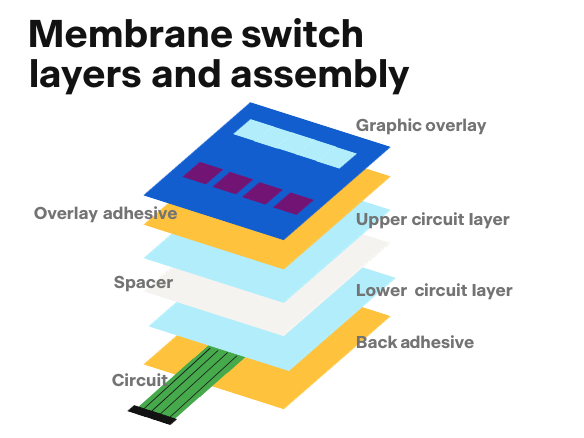Introduction of Membrane Switch Assembly
In today’s technology-driven world, the membrane switch assembly stands out as a critical component in various electronic devices. This comprehensive guide delves into the construction, applications, and benefits of membrane switch assemblies, shedding light on why they have become indispensable in modern electronics.

What is Membrane Switch Assembly?
A Thin, Flexible, and Durable User Interface
A membrane switch assembly is a user interface technology known for its thin, flexible, and durable nature. It integrates multiple layers to create a functional and visually appealing user interface. Typically, the assembly consists of four primary layers: the top layer (also called the dome or tactile layer), the graphic overlay, the membrane, and the bottom layer (electronic circuit).
The Top Layer: Dome or Tactile Layer
Providing Tactile Feedback for Enhanced User Interaction
The top layer, commonly referred to as the dome or tactile layer, plays a crucial role in providing tactile feedback to users when a button is pressed. Made from a thermoplastic elastomer material, this layer can be molded into a dome shape, enhancing the sensitivity and responsiveness of the switch.
The Graphic Overlay: The Face of the Switch
Ensuring User-Friendly and Visually Appealing Interfaces
The graphic overlay is the layer users directly interact with, featuring printed symbols, labels, or graphics that represent the buttons. This layer is vital for making the switch user-friendly and visually appealing, contributing to the overall design and usability of the device.
The Membrane Layer: The Conductive Heart
Connecting Circuits to Trigger Functions
Sandwiched between the top layer and the graphic overlay, the membrane layer houses conductive ink patterns that form the electrical contacts. When a button is pressed, the membrane layer compresses, allowing the conductive ink to connect with the circuit, thus completing the electrical circuit and triggering the desired function.
The Bottom Layer: The Electronic Circuit
The Core of Functionality
The bottom layer, or electronic circuit, is the core of the membrane switch assembly, containing the necessary electronic components like LEDs, resistors, and microcontrollers. This circuit is meticulously designed to align with the conductive ink patterns on the membrane layer, ensuring the switch operates as intended.
Applications and Advantages of Membrane Switch Assemblies
Versatile, Reliable, and Durable Solutions Across Industries
Membrane switch assemblies are employed across various industries, including automotive, medical, and consumer electronics. They offer numerous advantages, such as high reliability, durability, and resistance to environmental factors like moisture, dust, and extreme temperatures. Additionally, their ability to be customized for specific design and functional needs makes them a versatile solution for diverse applications.
Conclusion: The Continued Relevance of Membrane Switch Assembly
Membrane switch assemblies are a vital part of modern technology, providing user-friendly, durable, and customizable interfaces for electronic devices. By understanding their construction and function, designers, engineers, and manufacturers can develop more effective and efficient products. As technology advances, membrane switch assemblies will undoubtedly continue to play a crucial role in creating innovative and user-friendly electronic solutions.
Membrane Switch Assembly: FAQ Summary
1. What is a membrane switch assembly?
A membrane switch assembly is a thin, flexible, and durable user interface technology used in various electronic devices. It integrates multiple layers to create a functional and aesthetically pleasing user interface.
2. What are the key components of a membrane switch assembly?
The key components include:
Top Layer (Dome or Tactile Layer):Provides tactile feedback when a button is pressed.
Graphic Overlay:Displays symbols, labels, or graphics for user interaction.
Membrane Layer:Contains conductive ink patterns that complete the electrical circuit when pressed.
Bottom Layer (Electronic Circuit):Houses the electronic components like LEDs, resistors, and microcontrollers.
3.How does the membrane switch work?
When a user presses a button, the membrane layer compresses, allowing the conductive ink to connect with the electronic circuit in the bottom layer, completing the electrical circuit and triggering the desired function.
4.What materials are used in the top layer of a membrane switch?
The top layer is typically made of a thermoplastic elastomer material, molded into a dome shape to enhance the switch’s sensitivity and responsiveness.
5.What are the advantages of using membrane switch assemblies?
Membrane switch assemblies offer high reliability, durability, and resistance to environmental factors like moisture, dust, and extreme temperatures. They can also be customized to meet specific design and functional requirements.
6.In which industries are membrane switch assemblies commonly used?
They are widely used in industries such as automotive, medical, and consumer electronics.
7.Why are membrane switch assemblies important in modern technology?
They provide a user-friendly, durable, and customizable interface solution, essential for developing innovative and efficient electronic devices.
